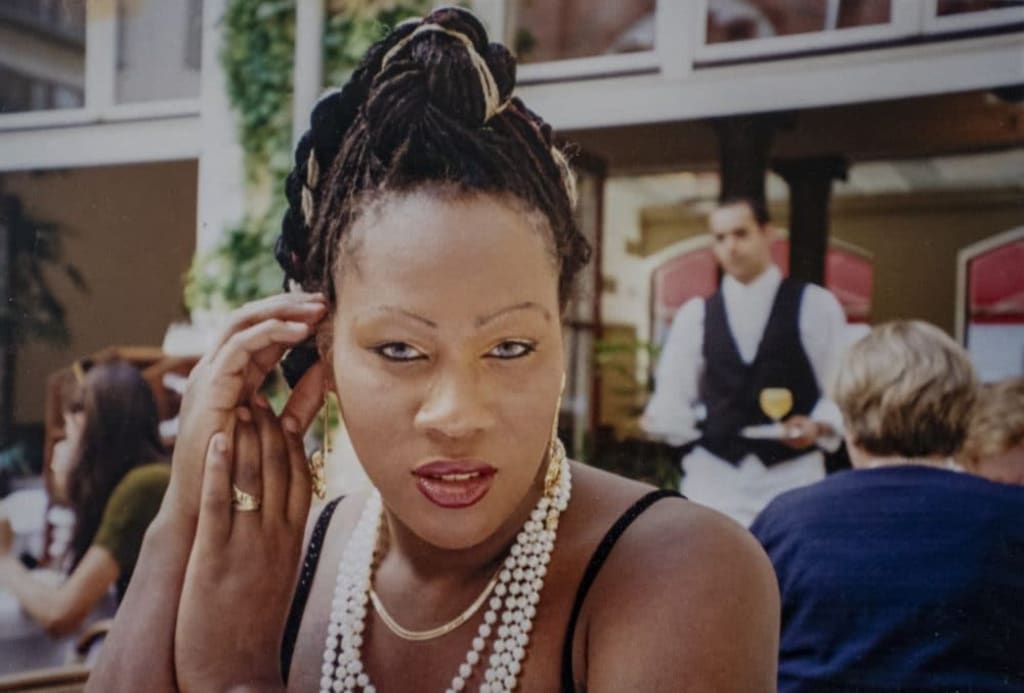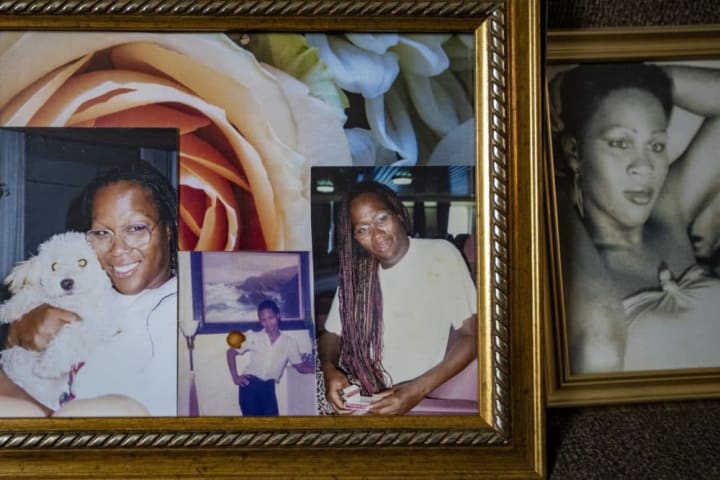The Unsolved Murder That Inspired Transgender Day Of Remembrance
Rita Hester, a Black transgender woman, was stabbed to death in her Boston apartment.

Rita Hester was a 34-year-old transgender woman from Hartford, Connecticut. According to her younger sister Diana, Rita always knew she was a woman, and her family was supportive of her identity,
“I kind of always knew, just the very feminine ways that she was and everything. My entire family, you know, even my nieces and nephew, everybody knew Rita. It was very receptive. Was no issue whatsoever. You know, it was fine.”
But she didn’t find Hartford so accepting and decided to move to Allston, Boston. Rita owned a cat and a boa constrictor. A musician and dancer, she was a fixture in the rock scene, often traveling to Greece to perform.
Rita was a regular at local straight and queer bars, which worried some of her friends. Melinda Wilson, a Black trans performer in Boston, warned her of the dangers trans people face in certain places,
“I kept telling her, I said, ‘Baby, just because you are the way you are, don’t be thinking you can go up into these straight clubs thinking you can just pick up anybody.’”
Another friend, Jessica Piper, noted that Rita was one of the few who hung out in Allston,
“(…) in Boston, she hung out in two different cultures, on opposite sides of town, and she was one of the only links between the two. The other queens wouldn’t go out to Allston from fear. And the straight Allston kids didn’t want to go to downtown queen bars.”
Rita spent the morning of November 28, 1998, playing racquetball with her best friend, Brenda Wynne. She left her friend’s house around noon but made plans to return that night to watch figure skating. However, Rita never did return. Brenda wasn’t concerned as she assumed Rita had met someone and forgot to cancel.
Around 4 PM, Rita called another friend, and they made plans to meet at the Silhouette Lounge, around the corner from her first-floor apartment on Park Vale Avenue. But when the friend went to meet her just after 7 PM, there were police on Rita’s street,
“I walk to the Silhouette, and I see her street was blocked with cops, and I’m like, ‘What happened?’ and I have a bad feeling.”
A next-door neighbor had called the police at 6:12 PM about a fight at Rita’s apartment. Officers were dispatched 7 minutes later. The neighbor later told Diana it took police a while to enter the apartment, even though the back door was open. Rita was still alive when they found her. She had been stabbed 20 times in the chest and died of cardiac arrest just before arriving at Beth Israel Hospital.
Over an hour passed between the time officers were dispatched and an ambulance took Rita to the hospital. She was just two days away from her 35th birthday.
There were no signs of a forced entry at Rita’s apartment, and nothing had been stolen. Her phone had been ripped from the wall. Blood was on the walls and floor, along with a half shoe print that didn’t belong to Rita.
According to Diana, neighbors had seen two white men leaving the building just after 6 PM.
Rita had been in a relationship with a man named Bobby for several years. Although friends and family couldn’t remember his last name, they described him as white and blond. It is unknown what kind of relationship the two had, as Rita was a private person, but Brenda said Bobby was “her main guy.” After Rita’s murder, no one saw him again.
Family and friends believe authorities failed to take Rita’s murder seriously. Her mother, Kathleen Hester, pointed to two reasons why,
“Why I think they didn’t handle it? For two reasons: One, she was gay or whatever they want to call it, and second, she was black and poor, and that’s why they didn’t care. They did not care.”
On top of that, Rita’s portrayal in the media received backlash from the LGBTQ community. The Boston Herald referred to her as a “transvestite” while The Boston Globe described her as a “nightclub singer and a party-thrower, a man who sported long braids and preferred women’s clothes.”
But it wasn’t just mainstream newspapers that resorted to misgendering and deadnaming. Bay Windows, Boston’s biggest LGBTQ newspaper, was also heavily criticized for how it covered Rita’s murder.
Articles referred to the victim as an “Allston man” and used her former name, despite including quotes from Kathleen in which she calls her daughter Rita. Then editor Jeff Epperly accused critics of acting as “thought police.”
Epperly continued misgendering Rita, citing The Associated Press Stylebook as the reason. At the time, the guide recommended using trans people’s new names and pronouns only if they had transitioned surgically. In 2020, Epperly admitted this decision was “indefensible.”
Inspired by Rita’s murder and subsequent media coverage, trans activist Gwendolyn Ann Smith created Remembering Our Dead, a web project honoring the lives lost to anti-trans violence.
In 1999, she launched Transgender Day of Remembrance, an annual vigil for trans murder victims. The first two marches took place in Boston and San Francisco on the anniversary of Rita’s death. However, the date has since been changed from November 28 to November 20 so as not to conflict with Thanksgiving. Vigils and marches are now held worldwide.
In 2014, Gwendolyn wrote an op-ed for the Advocate,
“When the Transgender Day of Remembrance first began, trans people were nameless victims in many cases. Our killers would do their best to erase our existence from the world. And law enforcement, the media, and others would continue the job. We would be regularly, consistently misgendered and labeled with names we did not choose — that is, when we weren’t simply reported as ‘unknown man in women’s clothing’ or ‘bearded woman.’”
Although support for the transgender community has grown since Rita’s murder, 2021 was the deadliest year for trans people in the US. With at least 50 murders, Black transwomen were disproportionately affected. The number is likely higher as trans victims are often misgendered, deadnamed, and underreported.
In 1997, Rita was quoted in In Newsweekly regarding the trial of William Palmer. William had killed 23-year-old Chanelle Pickett during a sexual encounter. His attorney used the “trans panic” defense, suggesting William’s homicidal reaction had been warranted, as he claimed to have not known Chanelle was a trans woman. He was acquitted of murder and sentenced to two years for assault and battery. The “LGBTQ panic” defense is still being used today.
Rita shared her concerns in an unsettling response,
“I’m afraid of what will happen if he gets off lightly. It’ll just give people a message that it’s OK to do this. This is a message we cannot afford to send.”
Rita Hester’s murder has been unsolved for 24 years. Kathleen is now in her 80s and worries she will pass away without knowing who killed her daughter. At a vigil attended by 250 mourners, the mother gave an emotional speech,
“I would have gladly died for you, Rita. I would have taken the stabs and told you to run. I loved you.”

About the Creator
Cat Leigh
Visit my publication on Medium for more true crime cases.
❤️ You can support my work on Ko-fi.
Enjoyed the story? Support the Creator.
Subscribe for free to receive all their stories in your feed. You could also pledge your support or give them a one-off tip, letting them know you appreciate their work.






Comments
There are no comments for this story
Be the first to respond and start the conversation.